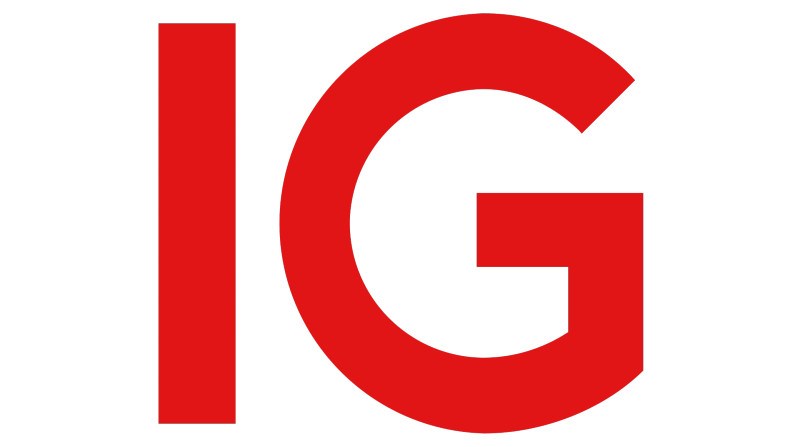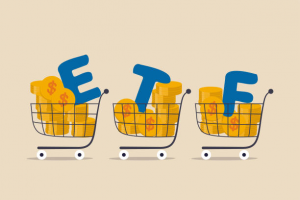Disclosure: Privacy Australia is community-supported. We may earn a commission when you buy a VPN through one of our links. Learn more.
Best ETF Apps in 2024

Exchange-Traded Funds (ETFs) are big collections of bonds or stocks, handled by expert funds managers, yet assets all neatly wrapped into a single fund.
Including your investment in this fund (learn more below) gives you the combined diversification of mutual funds but with a much lower investment minimum and real-time pricing.
This means you’ll be able to passively participate in the major stock exchanges, such as the NASDAQ and New York Stock Exchange. And with the latest consumer tech, from your fingertips. So, in this guide, we’re going to cover the best ETF apps.
Table of Contents:
- How We Choose our Platforms
- Reviews
- 1. eToro
- 2. Plus500
- 3. IG Markets
- 4. Pepperstone
- ETF Guide
- Steps For Participating In ETFs
- FAQs
How We Choose our Platforms 📚
The following brokers were curated by our team. Whatever ETF provider you end up with, consider that the user often matters more vitally than the tool, so take time to know your strategy, adapt to your chosen service and use good financial common sense.
Best ETFs – Our Reviews
Once upon a time, online trading was clunky. Now, we have luxury at our fingertips. But more information isn’t necessarily more power. Start from your experience level and time to learn. eToro offers the best safety features for newbies.
1. eToro (Our #1 Choice Overall)
Key Features:
- Minimum account funds: $50
- More than 2000 securities: shorts, ETFs, crypto
- Number of indexes: 13
- Auto-configure to specific market segments
Pros
- Great for diversifying investments at the tap of a button
- Social feeds display ideas, and discuss trading decisions
- Most traded includes: Bitcoin (number 1), Tesla, oil commodity
Cons
- Fee for converting Australian dollars U.S. dollars
📓 Reputation
A much safer alternative, for somebody who is looking to save surplus money that could become retirement money.
ETFs give you an opportunity to diversify your portfolio. Unlock up to 264 types of exchange-traded funds, for a flexible, deep way of investing into the financial markets with minimal upfront costs and lower management charges – which means eToro is a strong tool for portfolio diversification. You’re also not restricted to just trading ETFs; choose to invest in exchange-traded funds as an underlying asset itself.
eToro is a licensed and well-regulated broker (CySEC, Australia’s ASIC, and the FCA all regulate the platform); meaning that you can do trading of stocks, cryptocurrencies, and ETFs.
You can directly trade ETF as an underlying asset, which vastly reduces the amount of risk involved. Take your strategy to mirror the most similar trailers to your personality and goals, such as stability and long-term efficiency.
2. Plus500
Key Features:
- Deposit minimum: AUD200
- Indices include: USA 500, US-Tech 100, ASX 200
- Most traded blue chips: Tesla, Alibaba
- CFDs only

CFDs are a leveraged product and can result in the loss of your entire balance. Trading CFDs may not be suitable for you. Please consider whether you fall within Plus500’s Target Market Determination available in their Terms and Agreements. Please ensure you fully understand the risks involved.
Pros
- More than 2,500 CFD tradable assets
- Availability of crypto coins: 8
- Quick to open a demo account
- Easy to get started
Cons
- All assets must be CFD based
📓 Reputation
Thought I’d start with the most exciting (and dangerous) exchange-fund trade choice. While it’s powerful, this can turn against you.
Plus500 uses Contracts for Differences. But understand that CFDs are complicated instruments that come with a high risk of a rapid downside because of their leverage. Indeed, the majority of trade accounts lose money when they trade with CFDs across most providers. If you are willing to invest surplus funds aggressively, then this is an option.
3. IG Markets
Key Features:
- Commission fee: Yes
- Funding minimum: $250
- Leverage: 1:30 standard
- Assets include: forex, crypto, penny, ETFs, CFDs
- Indexes available: 22
- Basic copy trading + IG community portal

Pros
- Around since 2006
- Large range of securities: both standard and uncommon
- Ability to match trades of popular traders
Cons
- $250 needed to begin trading
- Moderately high commissions
- Cryptocurrency list still developing (only 20 different types so far)
📓 Reputation
The main benefit of using IG Markets’ ETF trading is that you get exposed to numerous assets in a single trade. This saves an enormous amount of time investing in different securities available. Indeed, there are more than 5,400 ETF markets that stretch across sectors, commodities, currencies, and indices.
The top benefit is diversification. You’re able to own multiple assets in just one trade. This is another high-risk route, however. While this means you get a very small initial deposit, increase opportunities to markets, and so lots of room for ROI, your basket of stocks is more volatile than if purchased directly.
4. Pepperstone
Key Features:
- Inactivity fee: Yes (+ commissions, spread)
- Account minimum: AUD$200
- Live trading minimum: AUD$200
- Access: ETFs, forex, crypto, penny, CFDs, more
- Indexes available: 23
- DupliTrade copy trading (non-proprietary) + Myfxbook account mirroring

Pros
- 89,000+ traders
- Regulated by both ASIC and FCA
- Offers liquidity previously only available to banks and hedge funds
Cons
- None of the perks of actual shareholders due to CFD route
- AUD$200 needed to start trading
- Charges commissions
- Not great for people who want access to lots of meme crypto-coins
📓 Reputation
Similar to number one and number three on this list. You can trade ETFs CFDs using Pepperstone. They have over 100 ETFs to choose from, which stretch across sectors such as energy, mining, but markets, technology, and retail. These also span across 35 countries on six continents. So, to put a specific portion of your set-aside money to aggressive use, Pepperstone has a large number of indices it trades on. Commissions are applicable but pretty cheap.
Once again, the main thing here is being able to trade more with less capital, i.e. putting a small portion to use for venture capitalism; expecting risks but also soaking up potential “moon shots”.
ETF Guide
Let’s cover key concepts related to closing short position. This will give you more context before starting your new journey:
Definition: Exchange-Traded Fund (ETF) 🏦
ETFs, or exchange-traded funds, are a form of shared investment security that works similarly to mutual funds. This normally focuses on a specific sector, commodity, index, or another asset, but an ETF differs from mutual funds as it can be bought or sold on the stock exchange in the same way as buying or selling a regular stock.
You can structure an ETF to track down to a single specific commodity, all the way up to a wide-ranging and large collection of securities. And it can even be structured to track a specific investment strategy:
- ☑️ An exchange-traded fund (ETF) the pool of securities that operate on the exchange in the same way as stocks.
- ☑️ As with regular stocks: the price of an ETF varies throughout the day while the ETF is purchased or sold according to the current market price; which contrast to mutual funds, which are traded once per day after market closure.
- ☑️ ETFs can contain a basket of investments, that include stocks, bonds, or commodities; while some only include U.S..holdings, others are international.
- ☑️ ETFs structurally work differently to mutual funds, but offer many of the same benefits. Meanwhile, expense ratios are lower and broker commissions less burden than purchasing stocks individually.
The Basics: How Exchange-Traded Funds Work

ETFs are called “exchange-traded” funds because they deal on the financial exchange just like stocks. Just as with stocks, the value of an ETF will vary across the day according to the number of shares bought. Also the timing, and the real-time value of the market.
By comparison, mutual funds are not actually traded on the exchange; mutual fund trades only occur once a day after the market has closed. ETFs tend to overall be a more budget-friendly and liquid alternative to mutual funds.
The key difference between an ETF and a stock is that exchange-traded funds track multiple underlying assets, rather than a single one. This makes an ETF attractive for investors who are looking for multiple assets as a way for diversification of their investment portfolio.
Many investment types can be bundled up inside of a single ETF, including commodities, bonds, stocks, as well as a mixture of investment instruments. ETS often contain hundreds or thousands of stocks – and these can be further diversified to be cross-sector or cross-industry, or isolated to a specific industry or sector.
Also, an ETF can be confined to the US or spread across global markets. One example of an industry-specific ETF is a banking-oriented ETF that stores stocks of numerous banks in the industry.
ETF Types 📉

Various types of ETFs exist that are open to investors for income generation, hedging or offsetting risks from bigger portfolios, speculation, and more. Here is a brief overview of a few of the ETFs accessible on the market now:
☑️ Bond ETFs
The bond ETF is designed to offer regular investor revenue. This is an income that can be closer to a reliable stream. How income actually unfolds will be weighted by the performance of underlying bonds.
Each underlying bond will have a maturity date, however, the bond ETF itself does not. These underlying bonds may include corporate bonds, state or local bonds (also known as municipal bonds), and government bonds.
☑️ Stock ETFs
A stock or equity ETF ties together a collection of stocks that focus on one sector or industry. For instance, a stock ETF might follow foreign or software-company stocks.
The goal is to offer diversified participation in a single industry, one with strong performers and new upstarts with high potential for growth. Fees are lower, there is no direct ownership of securities as compared to stock mutual funds.
☑️ Commodity ETFs
As indicated by the name, commodity ETFs track commodities, including investments in gold or crude oil. There are several benefits to using a commodity ETF. To start with, they provide natural diversification, for hedging or offsetting against downturns.
For instance, a commodity ETF can cushion a wider portfolio during a depreciation or recession in the stock market. Second, it’s cheaper to hold commodity ETF shares than it is to physically possess the commodity itself. This is because holding shares in commodities doesn’t require storage or insurance fees.
☑️ Sector/industry ETFs
A sector or industry ETF exchange-transfer fund is specific to a sector or industry. For instance, an energy sector ETF is a basket of firms operating in whatever that sector is. The principle behind industry ETFs is to allow participation in industry up-swings, by tracking the performance of firms working in their area.
One such illustration of this at work is the technology arena, which saw a boom in funds in recent years. Equally, drawbacks of the riskier stocks included in the basket, according to their performance are lessened because ETF holders do not actually have ownership of securities. This type of ETF investment vehicle is additionally used to cycle in and out of arenas during the economic calendar.
☑️ Currency ETFs
A currency ETF brings together numerous performing currency pairs operating in the forex markets and combines foreign and domestic currencies. There are various aims of current ETFs.
The first is to price-forecast currency values according to economic and political developments underway in a country. The second is to diversify a portfolio and hedge against importer and exporter volatility. Certain current ETFs can also be used for offsetting against inflation hazards. Even Bitcoin has an ETF (Futures) option.
☑️ Leveraged ETFs
Leveraged ETFs are used to amplify an investment by multiples of factors (for instance, 3x or 4x) – from the original value of its basket of underlying assets.
For example, let’s say the NASDAQ rises by a percent; a 2x leveraged NASDAQ ETF will reward the trader by 2% (similarly, if the index slumps a percent, the ETF will drop 2%). This vehicle uses derivatives like futures or options to facilitate its profits. You can also inversely leverage an ETF, in order to inversely multiply a return. Be aware of the risks involved and the possibility of capital losses.
☑️ Inverse ETFs
Continuing on from the above, inverse ETFs seek to profit from slumps in stocks by shorting stocks. When you short of stock, you are selling it while anticipating it will drop in value, so that you can purchase it for cheaper.
This investment vehicle uses derivatives to short stocks. In essence, they are speculations on market declines. If a prediction is correct and the market declines, an inverse ETF proportionally grows in value. It’s important to know that a great number of inverse ETFs are, in fact, not truly ETFs – but are instead exchanged trade-notes (ETNs).
While an ETF is indeed a bond, it trades as though it was a stock and is issuer-backed (for instance, by a bank). So make sure to confirm with your broker, to clarify if an ETN is a good match for your portfolio.
Steps For Participating In ETFs 👣

1. Choose your favourite ETF app. This will be your investment platform and hub. You can find ETFs on most online investment platforms and apps such as Robinhood. You can normally find commission-less trading, too, so that the platform does not request fees in order to trade ETFs. (This does not mean the absence of other prerequisite fees.)
The most distinguishing characteristics of a superior platform maybe it’s quality of service, convenience, and variety of instruments. For instance, ETF apps that are smartphone-optimized allow buying and selling ETFs at the tap of a button.
Whereas going through a brokerage may require filling out much paperwork or more complicated processes. *It’s worth noting that the most established brokerages do, however, provide comprehensive educational training material for inexperienced investors, on understanding ETFs.
2. ETF research. The second step to participating; there is a diverse range of ETFs on the market now. It’s important to recall while researching, that the ETF is unique from singular securities like bonds or stocks.
You need to be aware of the bigger picture – in the sense of industry or sector – when you go for an ETF. Here are a few questions you may want to contemplate while leading up to committing to an ETF product:
3. How long do you want to invest for?
4. Is your priority growth or revenue?
5. Most importantly, perhaps, do you have a specific industry or sector you are most drawn to or excited about?
6. Be aware of trading strategies: if you are inexperienced in ETFs, one common starter approach is sprinkling sum investments across a specific period of time. This is because any returns will also spread out over a specific time period, which is a good way to regiment investment (as compared to a tumultuous approach to trading).
During this longer initiation, starter investors can also absorb more sublime components of ETF investment. As ease of trading gradually increases, investors can branch out into more advanced strategies such as swing trading and sector cycling (which is used to synchronise with the economic cycle).
FAQs
What Are Actively Managed ETFs?
An ETF that is actively managed has a portfolio manager who is reasonably at hand for buying and selling shares of firms and modifying individual holdings inside of the fund. Normally, the more actively managed that an ETF is, the higher its expense ratio will be (as compared to a more passively-managed ETF).
Before committing to an ETF, it is important that investors are aware of whether a fund is actively or passively managed, its associated expense ratio, and the ratio of ROI versus fees.
ETF Swing Trading Tips
A few key ETF trading tips that might help you, if you are using a swing trading ETF strategy:
- ☑️ Always research before any purchase: You should be aware what your type of ETF seeks to accomplish, before trading it.
- ☑️ Choose the commission less broker or app: This will cut out any fees from switching funds between different providers.
- ☑️ Be attuned to charts: Traders should know when an ETF is on a trend, and also take into consideration resistance and support levels.
- ☑️ Know your open and close price-points ahead of time: To that end, limit orders may be superior to market orders.
What is the Best ETF to Invest In, In Australia?
Past performance can be a predictor of future performance but is by no means a guarantee. So with those hedging words of caution – based on performance by 1-year return; the three best Australia ETFs we have been able to pinpoint by research are the following:
- Xtrackers S&P/ASX 200 UCITS ETF 1D – Rate of 1 Year Return: 8.82%
- Lyxor Australia (S&P/ASX 200) UCITS ETF – Rate of 1 Year Return: 8.36%
- iShares MSCI Australia UCITS ETF – Rate of 1 Year Return: 8.12%
You Might Also Like:




